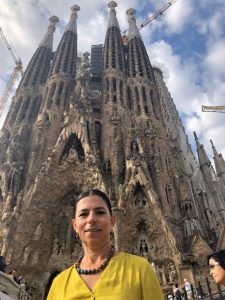1.4 Present Tense of SER (be verb)
1.4 Gramática: Present Tense of SER (be verb)
A. SUBJECT PRONOUNS (Los pronombres personales)
Before we start using verbs and constructing full sentences, we need to begin with personal pronouns which tell us WHO is doing the action in the sentence.
- Subject pronouns often replace a subject noun and can be classified in several different ways: by the person (first, second, or third person), number (singular or plural), gender (male or female), and formality (formal or informal).
- Subject pronouns can be used to replace a person’s name. However, many native speakers of Spanish rarely use them at all. This is because Spanish verb endings tell you who the subject is.
- The English pronoun IT is not expressed as a subject in Spanish.
Ejemplo: What is it? It is a book.
¿Qué es? Es un libro.
| SINGULAR | PLURAL |
| Yo (I) | Nosotros (We- all men, mixed group)
Nosotras (We-all women) |
| Tú (You, familiar/informal) | Vosotros (You all -Spain)
Vosotras (You all-Only women-Spain) |
| Usted (You, formal) | Ustedes (You all- Latin America) |
| Él (He) | Ellos (They-all men, mixed group) |
| Ella (She) | Ellas (They-all women) |
VIDEO: Spanish Subject Pronouns
 ACTIVIDAD # 1
ACTIVIDAD # 1
Escribir. Replace the following people with the appropriate subject pronoun.
- El señor y la señora Rodríguez
- Mi amigo
- Mi mamá y yo
- Patricia y María
- Los estudiantes
¡Inténtalo!
 ACTIVIDAD # 2
ACTIVIDAD # 2
Seleccionar. Fill in the blanks with the subject pronoun you would use to address the following people and also when talking about them.
Ejemplo: Don Pedro
Addressing him: usted Talking about him: él
- Las niñas
Addressing them: ______ Talking about them: ______
- Mi profesor de español
Addressing him: _______ Talking about him: _______
- José y Carmen
Addressing them: ______ Talking about them: ______
- Mi hermana (my sister)
Addressing her: _______ Talking about her: _______
- La doctora García
Addressing her: _______ Talking about her: _______
1.4 Present tense of SER
B. THE VERB SER
The verb SER in Spanish means “To Be” and is used to talk about the following*:
| “POND” Mnemonic Devices are a great technique for language learning |
Profession
Origen (Ser followed by “de”)
Nationality
Descriptions ( Personality and Physical Characteristics)
*We will learn more uses for “Ser” in lesson 5.
Ser-To be
| Singular | Plural |
| Yo Soy
|
Nosotr@s Somos
We are |
| Tú Eres
You (informal) are |
Vosotr@s Sois
You all are (Spain) |
| Usted (Ud.) Él Es EllaYou (formal) are, he/she is, it is* one thing-it |
Ustedes (Uds.) Ellos Son Ellas You all are (Lat.Am.), they are*2 + things |
Ejemplos:
- Profession = Yo soy enfermero (I am a nurse)
- Origin = Marta es de Uruguay. (Marta is from Uruguay)
- Nationality = Mis padres son chilenos. (My parents are Chilean)
- Description = Mi hermano es alto y amable (My brother is tall and nice)

María es de Colombia. Ella es colombiana y es profesora de español.
Ella es responsable y muy independiente.
Los cognados
|
 ACTIVIDAD # 1
ACTIVIDAD # 1
Seleccionar. Select the appropriate form of SER to complete the following sentences.
- Pedro (es, soy, somos) de México.
- Los estudiantes (somos, son, es) muy inteligentes.
- Mi mamá (son, eres, es) profesora de español.
- Shakira (es, son, eres) colombiana.
- ¿De dónde (son, es, eres) tú?
¡Inténtalo!
 ACTIVITY # 2
ACTIVITY # 2
Cambiar. Change the given sentences using the pronoun given and the appropriate conjugation of the verb SER.
Ejemplo: Nosotros somos profesores. Usted ES profesor.
1.Usted es de España. Ellos _____ ____ ________.
2.Nosotros somos estudiantes. Él ____ _______________.
3. Yo soy estudiante. Tú ________ _____________.
4. Ustedes son de México. Nosotros _______ ___ ______ .
5. Ella es enfermera. Yo ______ _____________ .
6. Tú eres de Ecuador. Ellas ______ ____ _________.
7. Ellos son americanos. Ustedes _____ ____________ .
 ACTIVIDAD # 3
ACTIVIDAD # 3
Descripciones. ¿Cómo eres? (¿Cómo es usted?). What are you like? Indicate all the appropriate words to describe yourself and others.
1. Yo soy. . . . .
______inteligente ______pesimista _______optimista
______ interesante ______ cruel _______tolerante
______terrible _______ impaciente _______?
2. Mi mejor amigo (a) (my best friend) es. . .
______inteligente ______pesimista _______optimista
______ interesante ______ cruel _______tolerante
______terrible _______ impaciente ______?
 ACTIVITY # 4 Write-Share
ACTIVITY # 4 Write-Share
El origen. Answer the questions below about where these people are from. Don´t forget to use “de” after SER when talking about origin.
- ¿De dónde eres?
- ¿De dónde es tu (your) mamá?
- ¿De dónde es tu papá?
- ¿De dónde son tus abuelos (grandparents)?
 ACTIVITY # 5
ACTIVITY # 5
¡Hablemos! With a partner, take turns asking and answering the following questions:
ESTUDIANTE A
- ¿De dónde eres?
- ¿Eres estudiante?
- Tus padres (parents) son estadounidenses?
- ¿Tu mamá es simpática (nice)?
- ¿Tu papá es doctor?
ESTUDIANTE B
- ¿De dónde eres?
- ¿Tu profesor (a) es de México?
- ¿Tu mejor amigo (a) (best friend) es inteligente?
- ¿Eres estudiante de portugués?
- ¿Tu papá es americano?
 ACTIVITY # 6: Read-Write-Share
ACTIVITY # 6: Read-Write-Share
First, let’s meet the following people. Then, write information about yourself and share it with the class.
Hola, ¿Qué hay de nuevo? Me llamo Cristiano Ronaldo. Soy de Portugal y SOY futbolista profesional, ¡el mejor! (the best). ¡Chao!

¡Hola! Me llamo Shakira. SOY de Colombia. ¿Cuál es mi profesión? SOY cantante. ¡Hasta luego!

¿Qué tal, estudiantes de español? SOY Guillermo del Toro y SOY mexicano. SOY director de cine (film). Nos vemos en el capítulo 4.

![]() It is your turn now.
It is your turn now.
__________________________________________________
___________________________________________________
___________________________________________________.

